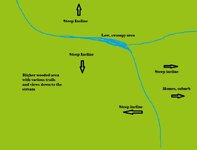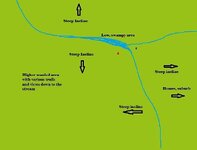Hi all,
New member (though long-time lurker--thank you so much for all of the information I've learned from this forum already!), based in Maryland.
I was hoping to draw on your collective knowledge as I put together a game-plan for a piece of private property I'm being permitted to hunt this season. I'm hoping to utilize both archery (which begins in early Sept here) and firearms (late Nov into early Dec). I'm relatively new to hunting, even though I'm in my late 40s; last year I harvested my first deer, on a different property, shooting from a stand with a 350 Legend---this is Maryland, after all. I'd say I trust myself out to about 30 yards with a bow; out to about 200 yards with a rifle. Anything past that would probably not be ethical for me at this point---working on it!
The property is about 75 acres, pretty much all heavily wooded. There are homes in several directions but all distant, and the topography provides plenty of backstoppage.
What I've created below is a sort of crude topo---the ones I've found online aren't especially helpful at this scale.
Details---with my question/s embedded.
The property, again, is almost all wooded: the only real clearings are in a low area that's swampy, with a stream running through it. Most of the property is high and dry with views down onto the lower swampy area/stream.
When I checked out the property last winter I saw deer sign all over (especially tracks in the snow, but also scrapes and rubs, etc), but never put eyes on a deer. I plan to set up a few cellular cams ahead of this season.
I'm wondering where an experienced hunter would place his/her cams and/or blind or stand---I'll probably end up using my blind.
Although I found tracks everywhere--to the point where I didn't find them particularly informative (to my still-learning eyes), my guess is that the deer are usually going to want to stay low, near the water, both because it's a source for drinking, and because they're more concealed down there--? So my instinct would be to keep out of those low-lying areas as much as possible: maybe position my cams looking down into the ravine/onto the swampy area, but not actually in that area--? And try to place/conceal my blind almost as if it were a sort of stand---which is to say, position high up on the incline looking down onto the swampy area, again trying not to intrude on the low-lying area at all.
My goal, if the property-owner will allow it, is to get the blind set up and staked down several weeks before hunting begins, so that the local deer will be used to seeing and smelling it. But here too I'm very open to advice!
I didn't recognize any major food sources on the property. There are a few oaks and quite a bit of browse: the reason the property-owner wants deer managed here is because of overbrowsing. But I wouldn't say there were any noticeable hotspots for food--again to my still-learning eyes. There are patches of heavier cover in the higher areas where I could imagine deer bedding down. But I can't shake the feeling that the main attraction of this property would be the water...
Thank you in advance--to anyone who read this far!--for your thoughts. I came to this hobby later in life than I should have, and it's been deeply educational and humbling. But man is putting good meat on the table. (My wife is only willing to eat so many catfish and stripers and perch.)

New member (though long-time lurker--thank you so much for all of the information I've learned from this forum already!), based in Maryland.
I was hoping to draw on your collective knowledge as I put together a game-plan for a piece of private property I'm being permitted to hunt this season. I'm hoping to utilize both archery (which begins in early Sept here) and firearms (late Nov into early Dec). I'm relatively new to hunting, even though I'm in my late 40s; last year I harvested my first deer, on a different property, shooting from a stand with a 350 Legend---this is Maryland, after all. I'd say I trust myself out to about 30 yards with a bow; out to about 200 yards with a rifle. Anything past that would probably not be ethical for me at this point---working on it!
The property is about 75 acres, pretty much all heavily wooded. There are homes in several directions but all distant, and the topography provides plenty of backstoppage.
What I've created below is a sort of crude topo---the ones I've found online aren't especially helpful at this scale.
Details---with my question/s embedded.
The property, again, is almost all wooded: the only real clearings are in a low area that's swampy, with a stream running through it. Most of the property is high and dry with views down onto the lower swampy area/stream.
When I checked out the property last winter I saw deer sign all over (especially tracks in the snow, but also scrapes and rubs, etc), but never put eyes on a deer. I plan to set up a few cellular cams ahead of this season.
I'm wondering where an experienced hunter would place his/her cams and/or blind or stand---I'll probably end up using my blind.
Although I found tracks everywhere--to the point where I didn't find them particularly informative (to my still-learning eyes), my guess is that the deer are usually going to want to stay low, near the water, both because it's a source for drinking, and because they're more concealed down there--? So my instinct would be to keep out of those low-lying areas as much as possible: maybe position my cams looking down into the ravine/onto the swampy area, but not actually in that area--? And try to place/conceal my blind almost as if it were a sort of stand---which is to say, position high up on the incline looking down onto the swampy area, again trying not to intrude on the low-lying area at all.
My goal, if the property-owner will allow it, is to get the blind set up and staked down several weeks before hunting begins, so that the local deer will be used to seeing and smelling it. But here too I'm very open to advice!
I didn't recognize any major food sources on the property. There are a few oaks and quite a bit of browse: the reason the property-owner wants deer managed here is because of overbrowsing. But I wouldn't say there were any noticeable hotspots for food--again to my still-learning eyes. There are patches of heavier cover in the higher areas where I could imagine deer bedding down. But I can't shake the feeling that the main attraction of this property would be the water...
Thank you in advance--to anyone who read this far!--for your thoughts. I came to this hobby later in life than I should have, and it's been deeply educational and humbling. But man is putting good meat on the table. (My wife is only willing to eat so many catfish and stripers and perch.)


